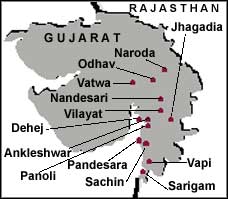Lethal overdose
 Gujarat is one of the most industrialised states in India. And pollution has been a direct fallout of industrialisation. In the last 38 years, after the creation of the state, the pattern of industrial growth has changed considerably. Textile industry, which formed 62 per cent of industries, has been replaced by chemicals industry,whose share has gone up from 13 per cent in 1960 to 39.10 per cent in 1997-98.
Gujarat is one of the most industrialised states in India. And pollution has been a direct fallout of industrialisation. In the last 38 years, after the creation of the state, the pattern of industrial growth has changed considerably. Textile industry, which formed 62 per cent of industries, has been replaced by chemicals industry,whose share has gone up from 13 per cent in 1960 to 39.10 per cent in 1997-98.
The Vadodara-Vapi axis, where most of the chemical industries are located, is on the brink of a disaster which might make the Bhopal gas tragedy look minor. Though a number of litigations forced several industries to close, the government is yet to understand the severity of the problem. The Indian Express reported on December 1, 1998, that of the Rs 1,18,765 crore earmarked for new investment in the state, chemicals and petrochemicals account for almost half: Rs 56,383 crore.
Ankleshwar estate, the so-called largest chemical zone of Asia, along with the Vadodara-Vapi axis has perhaps the deadliest combination of industries. And construction of a few more is in the pipeline. Environmental laws prescribe that hazardous estates should be at a distance of at least 25 km away from towns which have a population of about one million. But Jhagadia and Vilaya are at a distance of just 17 km from Ankleshwar and Bharuch railway stations respectively. Besides, Jhagadia, Ankleshwar and Panoli are all within 10 km of each other. Smoke from the tottering chimneys of the collapsing textile mills, and the harmful and deadly concentration of gases emitting from the industrial funnels is gradually making Gujarat a living hell.
It is not just industrial pollution that is ailing Gujarat. Vehicular pollution has also reached unbearable levels. An estimated 0.42 million registered motor vehicles are plying in the state. Of these, Ahmedabad alone has close to 100,000 vehicles, 70 per cent of which are two-wheelers.
A survey conducted by the National Institute of Occupational Health in October 1997 revealed that the Nehru Bridge corner in Ahmedabad had the highest levels of respiratory particulate matter which was 428 microgrammes per cubic metre (
